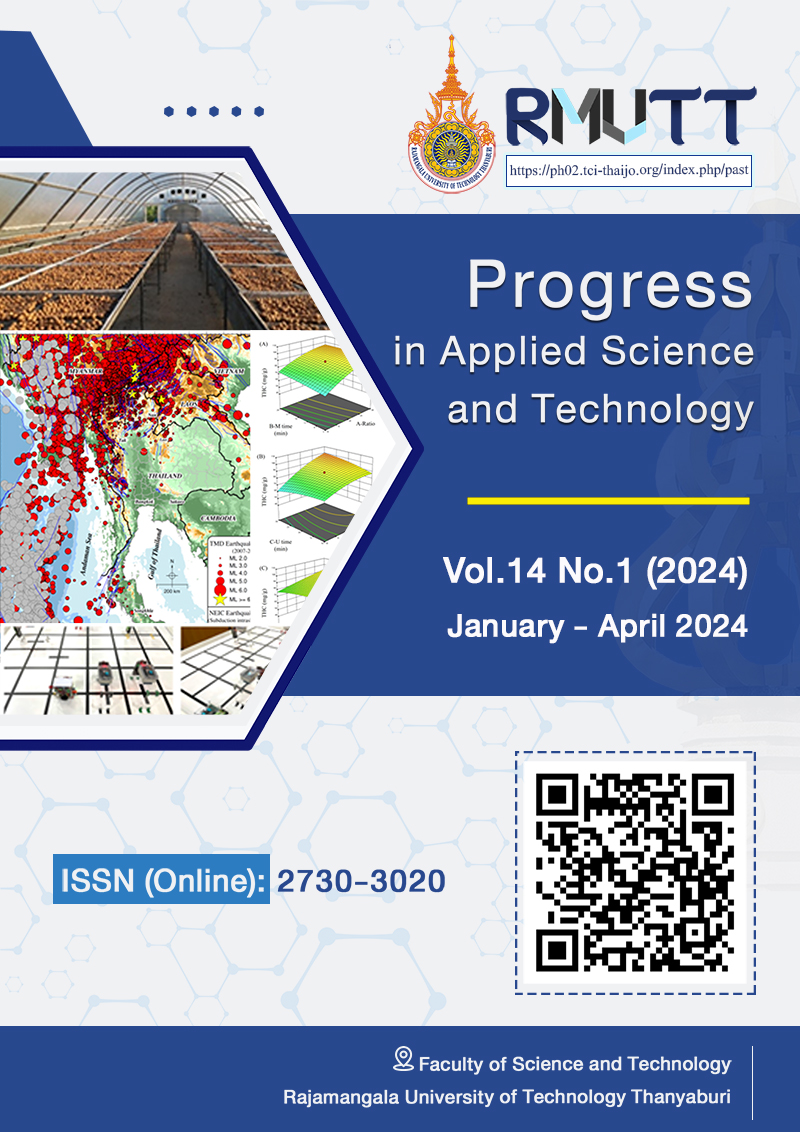Web-based Cooking Recipe Recommender System based on Stocked Groceries
Main Article Content
Abstract
Due to the severity of the recent PM 2.5 and COVID-19 pandemic situations, the work-from-home lifestyle has been widely adopted as a new normal. Consequently, it’s necessarily preferable to cook at home instead of dining out as usual. However, a common problem is that there are unplanned and overstocked grocery items which are usually unrecognized and improperly managed. To address this issue, the "What To Cook" web application was developed with the theoretical application of Term Frequency-Inverted Document Frequency (TF-IDF) calculations to search for recipes based on the stocked groceries and then applied Cosine Similarity to calculate the similarity between each recipe and the stocked grocery items. Users can input the list of own stocked grocery items into the application and then apply the content-based filtering system to recommend recipes that can utilize the stocked grocery items.
Additionally, the application supports the image capturing using Google Cloud Vision API. The application also stores the user's cooking history and saves the under interested recipes for future reference. After testing the application in real-world scenarios, it was found to be easy to use with satisfiable results.
Article Details

This work is licensed under a Creative Commons Attribution-NonCommercial-NoDerivatives 4.0 International License.
References
Abid MA, Mushtaq MF, Akram U, Abbasi MA, Rustam F. Comparative analysis of TF-IDF and loglikelihood method for keywords extraction of twitter data. Mehran Univ. Res. J. Eng. Technol. 2023;42(1):88–94.
Alharbe N, Rakrouki MA, Aljohani A. A collaborative filtering recommendation algorithm based on embedding representation. Expert Syst Appl. 2023;215: 1-11.
Amara S, Subramanian RR. Collaborating Personalized Recommender System and Content-based Recommender System Using TextCorpus. Proceedings of the 6th International Conference on Advanced Computing and Communication Systems (ICACCS); 2016 Jan 22-23; Coimbatore, India. p. 105-9.
Azizi M, Do H. A collaborative filtering recommender system for test case prioritization in web applications. Proceedings of the 33rd Annual ACM Symposium on Applied Computing (SAC '18). Association for Computing Machinery; 2018; New York, USA. p. 1560-7.
Bafna P, Pramod D, Vaidya A. Document clustering: TF-IDF approach. Proceeding of the 2016 International Conference on Electrical, Electronics, and Optimization Techniques (ICEEOT); 2016 March 3-5; Chennai, India. p. 61-6.
Burke R. Hybrid Recommender Systems: Survey and Experiments. User Model User-Adap Inter: Springer; 2002. (12). p. 331–70.
Çano E, Morisio M. Hybrid Recommender Systems: A Systematic Literature Review. Intell Data Anal. 2017;21(6):1487 – 1524. doi:10.3233/IDA-163209
Gomes L, Torres RDS, Côrtes ML. BERT- and TF-IDF-based feature extraction for long-lived bug prediction in FLOSS: A comparative study. Inform Software Tech. 2016;(160),107217:1-12.
Khatter H. Goel N, Gupta N, Gulati M. Movie Recommendation System using Cosine Similarity with Sentiment Analysis. Proceedings of the 2021 Third International Conference on Inventive Research in Computing Applications (ICIRCA); 2021 Sep 2-4; p. 597-603. doi: 10.1109/ICIRCA51532.2021
Lops, P, Gemmis MD, Semeraro G. Content-based Recommender Systems: State of the Art and Trends. In: Ricci, F., Rokach, L., Shapira, B., Kantor, P. (eds) Recommender Systems Handbook: Springer; 2011. https://doi.org/10.1007/978-0-387-85820-3_3.
Lu J, Wu D, Mao M, Wang W, Zhang G. Recommender system application developments: A survey. Decis Support Syst, 2015;(74):12-32.
Neves A, Lopes D. A practical study about the Google Vision API. Proceedings of the 22nd Portuguese Conference on Pattern Recognition; 2016; Aveiro, Portugal. Available from https://www.researchgate.net/publication/309642837_A_practical_study_about_the_Google_Vision_API
Papadakis H, Papagrigoriou A, Eleftherios K, Panagiotakis C, Markaki S, Fragopoulou P. Content-Based Recommender Systems Taxonomy. Found. Comput. Decis Sci. 2023;48(2):211-41.
Papadakis H, Papagrigoriou A, Panagiotakis C, Kosmas E, Fragopoulou P. Collaborative filtering recommender systems taxonomy. Knowl Inf Syst. 2022;64:35–74.
Park DH, Kim HK, Choi IY, Kim JK. A literature review and classification of recommender systems research. Expert Syst Appl. 2012;39(11):10059-72.
Pérez-Almaguer Y, Year R, Alzahrani AA, Martínez L. Content-based group recommender systems: A general taxonomy and further improvements. Expert Syst Appl. 2021;(184),115444:1-21. https://doi.org/10.1016/j.eswa.2021.115444
Qaiser S, Ali S. Text Mining: Use of TH-IDF to Examine the Relevance of Words to Documents. Int. J. Comput Appl. 2018;181(1):25-29.
Singh RH, Maurya S, Tripathi T, Narula T, Srivastav G. Movie Recommendation System using Cosine Similarity and KNN. Int J of Eng Adv Technolo. 2020;9(5):556-9.
Uthaisuri T. Keyword extraction from English abstracts [master's thesis]. Nakhon Pathom (TH), Silapakorn University; 2013.
Walek B, Fajmon P. A hybrid recommender system for an online store using a fuzzy expert system. Expert Syst Appl. 2023; (212):1-16. https://doi.org/10.1016/j.eswa.2022.118565.
Wu HC, Luk RWP, Wong KF, Kwok KL. Interpreting TF-IDF term weights as making relevance decisions, ACM Trans. Inf. Syst. 2018;26(3):1-37.
Zahrotun L. Comparison Jaccard similarity, Cosine Similarity and Combined Both of the Data Clustering with Shared Nearest Neighbor Method. Computer Engineering and Applications. 2016;5(1):11-8.
Zhang W, Yoshida T, Tang X. A comparative study of TF*IDF, LSI and multi-words for text classification. Expert Syst Appl. 2011;38(3):2758-65.






